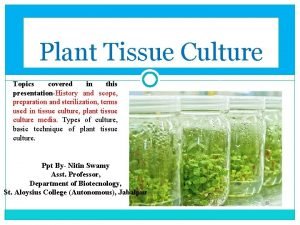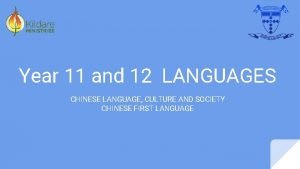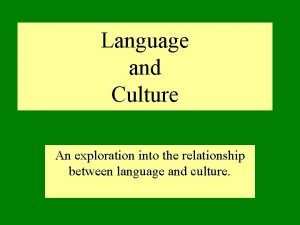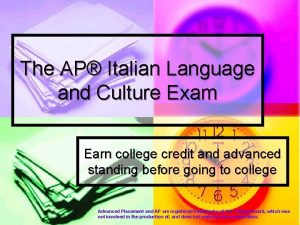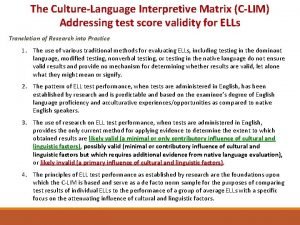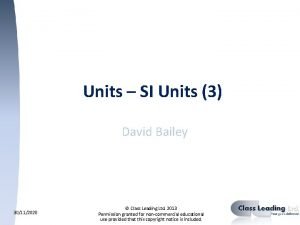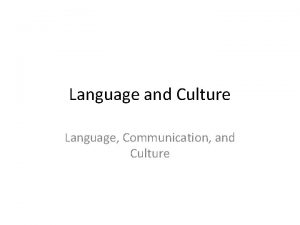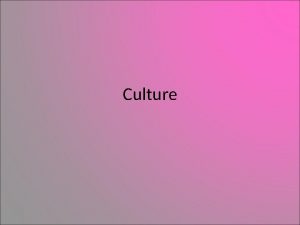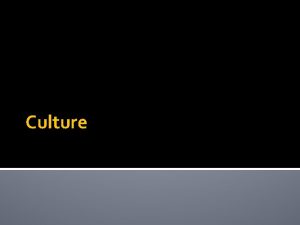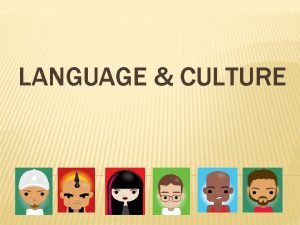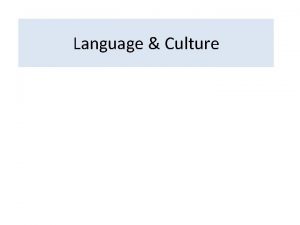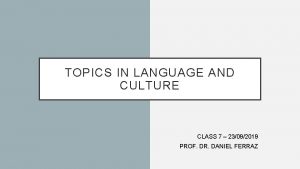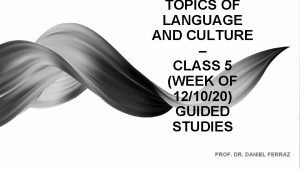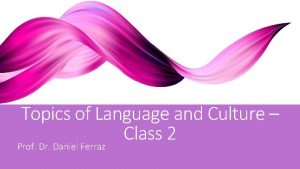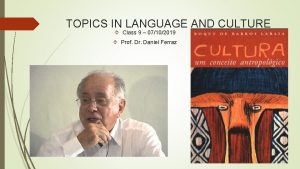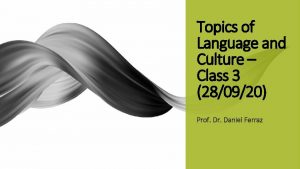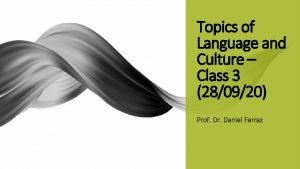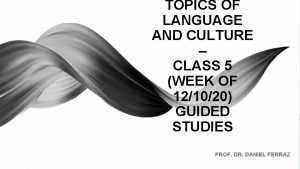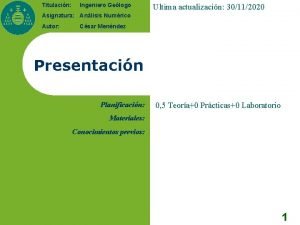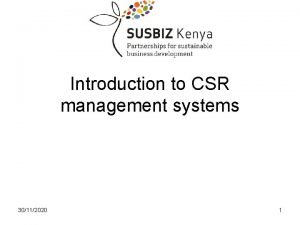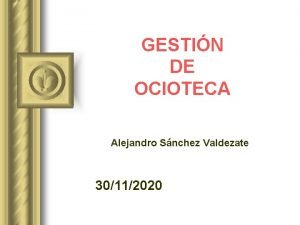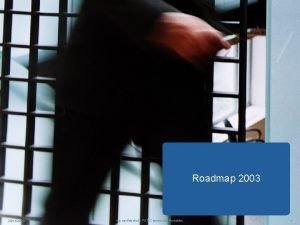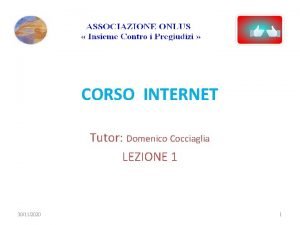TOPICS IN LANGUAGE AND CULTURE CLASS 11 30112020

































- Slides: 33

TOPICS IN LANGUAGE AND CULTURE CLASS 11 – 30/11/2020 PROF. DR. DANIEL FERRAZ

EAGLETON (II)– THE IDEA OF CULTURE HIS CRITIQUE FROM CULTURAL STUDIES CULTURE HAS BECOME TOO INDIVIDUAL POST-MODERN VIEWS OF CULTURE (ALSO UNIVERSAL) THE IDEA THAT IT CAN BE ANYTHING (THERE MUST BE A SCOPE)

(P. 35) THE IDEA OF CULTURE (BOOK)– TERRY EAGLETON It is hard to resist the conclusion that the word ‘culture’ is both too broad and too narrow to be greatly useful. Its anthropological meaning covers everything from hairstyles and drinking habits to how to address your husband’s second cousin, while the aesthetic sense of the word includes Igor Stravinsky but not science fiction.

https: //www. youtube. com/watch? v=skfq 5 F 2 Zuy. M&ab_channel=505 soaringea gle COFFEE CULTURE. . . A frase like ‘café culture’ means not just that people visit cafés but that some people visit them as a way of life, as they presumably do not in the case of their dentists. P. 39

CLASS 12 – HALL - PART I – A IDENTIDADE CULTURAL NA PÓS-MODERNIDADE OUTLINE INTRO – CINEMA – MOVIE SCENES AND TRAILERS – THE FRAGMENTED IDENTITY PART 1 – A IDENTIDADE CULTURAL NA PÓS-MODERNIDADE – SOME ASPECTS PART 2 – 5 DECENTERINGS + MORE CINEMA DISCCUSION – WRITTEN – WHAT IS CULTURE FOR HALL AND YOURSELF, THEN?

HTTPS: //WWW. YOUTUBE. CO M/WATCH? V=CAPAND 1 E_TU

FRAGMENTED IDENTITIES CRASH HTTPS: //WWW. YOUTUBE. COM/WAT CH? V=DEJH 0 HEOHC 4

ZEITGEIST (O ESPÍRITO DO TEMPO) HTTPS: //WWW. YOUTUBE. COM/W ATCH? V=5 R_VM 2 WCQJ 4

STUART HALL - THE QUESTION OF CULTURAL IDENTITY MODERNITY AND ITS FUTURES – ED. BY STUART HALL, DAVID HELD AND TONY MCGREW, UK: POLITY PRESS AND THE OPEN UNIVERSITY, 1992. Aim of the chapter: modern identities are being de-centred, that is, dislocated or fragmented. A CRISIS OF IDENTITY: seen as part of a wider process of change which is dislocating the central structures and processes of modern societies and undermining the frameworks which gave individuals stable anchorage in the social world. Fragmentation of the cultural landscapes of class, gender, sexuality, ethnicity, race, and nationality which gave us firm locations as social individuals. These transformations are also shifting our personal identities, undermining our sense of ourselves as integrated subjects. This loss of a stable ‘sense of self’ is sometimes called the dislocation or de-centring of the subject.

THREE CONCEPTS OF IDENTITY 1) The Enlightenment subject: was based on a conception of a human person as a fully centred, unified individual, endowed with the capacities of reason, consciousness and action, whose ‘centre’ consisted of an inner core which first emerged when the subject was born, and unfolded with it, while remaining essentially the same – continuous or identical with itself – throughout the individual existence. The essential centre of the self was the person’s identity).

THREE CONCEPTS OF IDENTITY ) The sociological subject reflected the growing complexity of the modern world and the awareness that this inner core of the subject was not autonomous and self-sufficient, but was formed in relation to ‘significant others’, who mediated to the subject the values, meanings and symbols – the culture – of the worls he/she inhabited. According to this view, identity is formed in the interaction between self and society. The subject still has an inner core or essence that is “the real me”, but this is formed and modified in a continuous dialogue with the cultural worlds ‘outside’ and the identities which 2

THREE CONCEPTS OF IDENTITY The post-modern subject: conceptualized as having no fixed, essential or permanent identity. Identity becomes a ‘moveable feast’: formed and transformed continuously in relation to the ways we are represented or addressed in the cultural systems which surround us. It is historically, not biologically, defined. 3) The subject assumes different identities at different times, identities which are not unified around a coherent ‘self’. If we feel we have a unified identity from birth to death, it is only because we construct a comforting story or narrative of the self about ourselves. The fully unified, completed, secure and coherent identity is a fantasy. Instead, as the systems of meaning and cultural representation multiply, we are confronted by a bewildering, fleeting multiplicity of possible identities, any one of which we could identify with – at least temporarily. (p. 277)

THE CHARACTER OF CHANGE IN LATE MODERNITY (P. 277) All that is solid melts into air… (Marx and Engels, The Communist manifesto, in Revolutions of 1848) Modern societies are therefore by definition societies of constant, rapid and permanent change. This is the principal distinction between ‘traditional’ and ‘modern’ societies. Giddens (The consequences of modernity) points the difference (p. 277 -278) and mentions that modernity is not only defined as the experience of living with rapid, extensive and continuous change, but is a highly reflexive form of life in which ‘social practices are constantly examined and reformed in the light of incoming information about those very practices, thus constitutively altering their character. The general point made is that of “discontinuities” (cf. Giddens’

THE CHARACTER OF CHANGE IN LATE MODERNITY (P. 277) David Harvey (The condition of Post-Modernity, 1989) speaks of modernity as not entailing ‘a ruthless break with any or all preceding conditions’, but as characterized by a never-ending process of internal ruptures and fragmentations within itself (1989, p. 12). Ernesto Laclau (New reflections on the revolution of our time, 1990) uses the concept of ‘dislocation’. A dislocated structure is one whose centre is displaced and not replaced by another, but by a plurality of power centres. Modern societies, Laclau argues, have no centre, no single articulating or organizing principle, and do not develop according

THE CHARACTER OF CHANGE IN LATE MODERNITY (P. 277) Laclau: late-modern societies are characterized by ‘difference’; they are cut through by different social divisions and social antagonisms which produce a variety of different ‘subject positions’ – i. e. identities – for individuals. . If such societies hold together at all, it is not because they are unified, but because their different elements and identities can, under certain circumstances, be articulated together. But this articulation is is always partial: the structure of identity remains open. Without this, Laclau argues, there would be no history. (p. 279)

HALL. . . FRAGMENTED IDENTITIES – WHAT DOES THIS MEAN? (CHAPTER 2) 5 SOCIOLOGICAL MOVEMENTS. . . DECENTERING 1. SOCIETY: MARXIST PHILOSOPHY 2. MEDICINE – FREUD /PSYCHOANALYSIS 3. LANGUAGE: SAUSSURE 4. PHILOSOPHY: Foucault 5. SOCIOLOGY: FEMINISM

MARXISM / ECONOMIC CLASS STRUGGLE (MODERN TIMES) HTTPS: //WWW. YOUTUBE. COM/WATCH? V=HPSK 4 ZZTZLI&LIST=RDHPSK 4 ZZTZLI &START_RADIO=1

2. FREUD – UNCOUNSCIOUS FRAGMENTED SUBJECT – POLIPHONIC BEING MALKOVICH HTTPS: //WWW. YOUTUBE. COM/W ATCH? V=2 UURFR 0 GNHM

FREUD – INCONSCIOUS DREAMS HTTPS: //WWW. YOUTUBE. COM/W ATCH? V=PFQYQU_R 5 BG

LANGUAGE – FROM SAUSSURE TO DERRIDA HTTPS: //WWW. YOUTUBE. COM/W ATCH? V=9 EADKRVBZJU

FOUCAULT – POWER DOGVILE HTTPS: //WWW. YOUTUBE. COM/WA TCH? V=J 5 -LQWUHTAM

FEMINISM – MONALISA S SMILE HTTPS: //WWW. YOUTUBE. COM/W ATCH? V=L-JIWYT 6 T 0 S

SUGGESTIONS FROM STUDENTS FILMS >> FEMINISM THE PIANO COLLETTE SALT OD EARTH BIG EYES

CHAPTER 3 – CULTURES AS NATION STATES NATION AS CULTURE

THE MYTHS OF A (MODERN) NATION 1. THE NARRATIVE OF THE NATION >>> BRAZIL AFTER PORTUGAL 2. ORIGINS, TRADITION AND CONTINUITY >>> MODERNITY (L & C) 3. INVENTION OF TRADITION>>> UNIVERSALISM, EDUCATION, POLITICS, ECONOMY 4. FOUNDATION MYTH>>> JESUITS, THE PORTUGUESE, THE EUROPEAN 5. THE FOLKS PEOPLE >>> THE MIXTURE OF RACES

DECONSTRUCTING NATIONAL CULTURE – IDENTITY AND DIFFERENCE 1. NATION FORMATION >>> VIOLENT PROCESSES, ERASURE OF CULTURAL DIFFERENCE, ESTABLISHMENT OF ONE LANGUAGE, ONE CULTURE 2. A “NATION” IS NECESSARILY FORMED BY DIVERSITY OF CLASSES, ETHNICITIES, RACES, GENDERS, ETC 3. NATIONS >>> EMPIRES, NEOLIBERALISM, MARKETS


ANSWERS FROM GOOGLEDOCS YOUR CONTRIBUTION DANIELF: I think that this questions discusses the , , , ] MARIA: I do believe that. . .



PART 1 – ANSWE R THESE QUESTI ONINGS

CP 5 – TO BE SENT TO DANIELFE@USP. BR CONNECT HALL S TEXT + TODAY S CLASS + ONE OF THE TEN PERSPECTIVES ON CULTURE (PREVIOUS CLASSES PPT!) AND WRITE A SHORT ESSAY, NO MORE THAN ONE PAGE -

THANK YOU!!!
 Plant tissue culture project topics
Plant tissue culture project topics Pop culture examples
Pop culture examples Continuous culture and batch culture
Continuous culture and batch culture Difference between american culture and indian culture
Difference between american culture and indian culture Uses of selenite f broth
Uses of selenite f broth Folk culture and popular culture venn diagram
Folk culture and popular culture venn diagram Folk culture and popular culture venn diagram
Folk culture and popular culture venn diagram Anaerobic media
Anaerobic media Folk culture and popular culture venn diagram
Folk culture and popular culture venn diagram Pour plate method
Pour plate method Robertson cooked meat medium
Robertson cooked meat medium Surface culture deep culture and esol
Surface culture deep culture and esol Found notice for class 7
Found notice for class 7 Presentation in hindi topic
Presentation in hindi topic Individual culture traits combine to form culture patterns.
Individual culture traits combine to form culture patterns. Batch culture vs continuous culture
Batch culture vs continuous culture Individualistic culture definition
Individualistic culture definition Counterculture vs subculture
Counterculture vs subculture Inert organizational culture
Inert organizational culture Characteristics of quality culture
Characteristics of quality culture Language and culture
Language and culture Language culture and curriculum
Language culture and curriculum Language in life
Language in life Relationship between language and culture
Relationship between language and culture Relationship between language and culture
Relationship between language and culture Ap italian language and culture
Ap italian language and culture Culture that generally pursued by the upper class
Culture that generally pursued by the upper class Difference between abstract class and concrete class
Difference between abstract class and concrete class Abstract concrete class relationship
Abstract concrete class relationship 7 rights of medication administration in order
7 rights of medication administration in order Java dynamic class loading
Java dynamic class loading Cultural linguistic interpretive matrix
Cultural linguistic interpretive matrix Today's class answers
Today's class answers Putting a package together
Putting a package together
